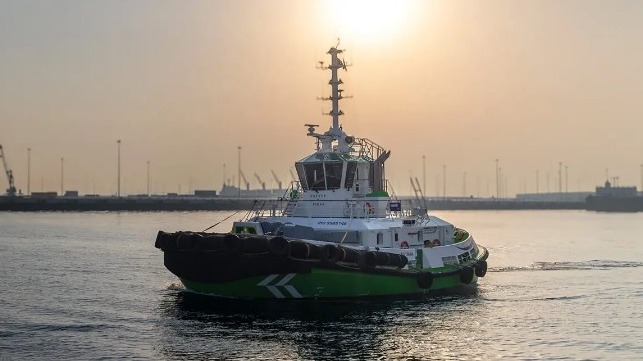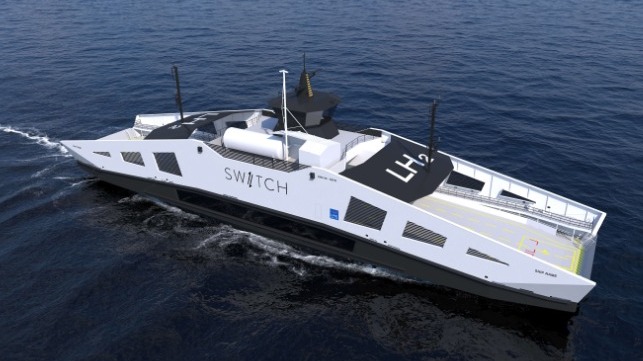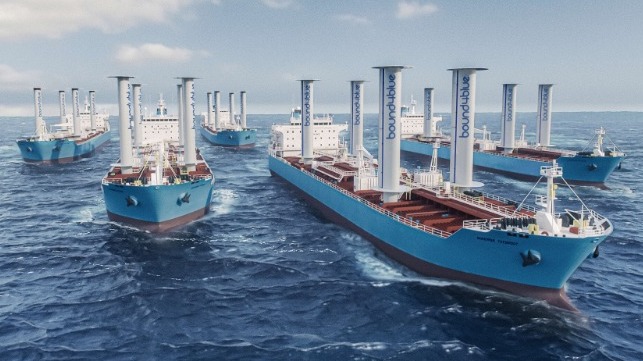ALT. FUEL
Guinness World Record for Power Set by Damen-Built Electric Tug in UAE

Fully electric tugs have quickly emerged from a novelty in the industry and now Damen Shipyards Group and its client SAFEEN Group, part of AD Ports Group’s Maritime & Shipping Cluster, have set a Guinness World Record as the Most Powerful Electric Tugboat. The vessel delivered earlier this year demonstrated what the companies are calling “unprecedented for a fully electric tug” and further the growth of this sector of the industry.
The record was set by measuring the bollard pull of Damen RSD-E Tug 2513 Bu Tinah, which achieved an average high peak pull of 78.2 tonnes. It is the first fully electric tug to operate in the Middle East and now has the unique distinction of the unique honor by a world-recognized body for record keeping. Launched in 1954 as a promotional idea for the Guinness Brewery, the Guinness Book of Records (today Guinness World Records) is an often-quoted source of data.
“This Guinness World Record achievement demonstrates that the transition to alternative energy does not come at the cost of performance,” said Captain Ammar Mubarak Al Shaiba, CEO – Maritime & Shipping Cluster, AD Ports Group. “We are very proud that the first electric tug in the Middle East is also making waves on a global level with this accolade and the fact that in parallel it is improving the sustainability of our operations alongside cost efficiencies in terms of overall fuel saving is extremely important.”
The record-breaking performance took place at Khalifa Port, AD Ports Group’s flagship facility where the tug is a key component of AD Ports Group’s Marine Services fleet and its electrification strategy.
The RSD-E Tug 2513 according to Damen is designed with a focus on sustainability. It offers zero emissions from tank to wake playing a significant role in reducing emissions.
The RSD-E Tug 2513 builds on the already efficient design of the diesel propulsion RSD Tug 2513. The spec sheet highlights a 320 gross ton tug with a length of 24.73 meters (81 feet). It is designed to operate at a speed of up to 12 knots and can be recharged in two hours.
The vessel can operate with a crew of just two or three persons or a maximum of up to sic and can be customized with options for oil and pollution control or fire fighting.
The electric version according to its spec sheet is very similar to the earlier diesel version which has a maximum bollard pull of 80 tonnes. It operates at a speed of 12.6 knots.
Damen has been at the forefront of electric tug development, including delivering the world’s first electric harbor tug, aptly named Sparky, in 2022 to Ports of Auckland. It won the prestigious “Tug of the Year” at the 2022 International Tug and Salvage Awards ceremony and pioneered the growing deployment of electric tugs in ports around the world.
Effort to Develop First U.S. Liquid Hydrogen-Fueled RoPax Ferry

An effort is underway to leverage the cutting-edge technology for hydrogen-fueled vessels to develop the first RoPax vehicle ferry in the U.S. to be fueled by liquid hydrogen. SWITCH Maritime, the U.S. shipowner that launched the first hydrogen-powered ferry in the U.S. is in collaboration with LH2 Shipping and LMG Marin in Norway to commence construction in the U.S. of a hydrogen-fueled RoPax ferry.
SWITCH’s first hydrogen-powered vessel, the Sea Change, is a 75-passenger catamaran ferry featuring 600 kW of electric motor propulsion, powered by 360 kW of fuel cells with 246 kilograms of gaseous H2 (GH2) storage at 250 bar pressure. The Sea Change started public passenger service as part of the San Francisco Bay Ferry system in July 2024, after receiving its final Certificate of Inspection (COI) from the U.S. Coast Guard in May 2024.
“With rigorous planning, state-of-the-art engineering, and support from leading industry partners and the U.S. Coast Guard, we are ready to pioneer zero-carbon LH2 fueling for heavier, higher-horsepower workboats,” explains Pace Ralli, Founder & CEO of SWITCH.
They plan to develop a vessel using the designs from LMG Marin for an 80-car, 300-passenger RoPax vehicle ferry. The design is already DNV classed and is being successfully operated by Norled. Named MF Hydra, the ferry performs a triangular six nautical mile round-trip fueled with liquid hydrogen (LH2). The companies highlight it has a four-tonne LH2 tank (about the size of a 40-foot container) that fits easily on the top deck and receives fuel from an LH2 truck via a bunkering system using over-pressure in the truck to push the liquid to the ship. To date, MF Hydra has successfully received LH2 fuel approximately 50 times since starting hydrogen-powered operations in March 2023.
The RoPax vehicle ferry will have a service speed of 14 knots and is expected to require fueling only once per week (volume of 3000 kilograms from one LH2 truck) in a typical operation, with no requirement for shoreside electric charging infrastructure. While the design will require some further adapting to meet USCG requirements, SWITCH notes the larger steel hull of the vehicle ferry offers more flexibility in terms of space and weight compared to aluminum catamaran fast ferry designs, making it an ideal platform for introducing LH2 fueling in the U.S. The LH2 from the cryogenic storage tanks is vaporized onboard and used in the PEM fuel cells to create electricity for the electric motors. Like the GH2 fast ferries, the vessel’s only emissions will be pure H20 vapor, with zero carbon or other diesel-related emissions.
In addition to the Sea Change, SWITCH is also working on a 150-passenger, 25-knot catamaran to build for the SF Bay Ferry service, using the same gaseous H2 (GH2) storage and fuel cell equipment as the first vessel (to be revealed in Q1 2025). When designing larger zero-emissions harbor craft such as 300+ passenger ferries, vehicle ferries, and harbor tugs, SWITCH plans to transition from gaseous storage to cryogenic liquid H2.
SWITCH has focused on hydrogen for its potential to serve as a viable option highlighting its belief that other battery-only solutions fall short due to space and weight constraints. The company notes that generally, hydrogen as a fuel source can support greater range and power requirements due to its high energy density. Additionally, it simplifies zero-emissions vessel operations by eliminating the need for fixed shoreside charging infrastructure, allowing for fueling through established truck-to-ship or ship-to-ship practices. Compressed GH2 SWITCH says is well suited for small- to medium-sized vessels; however, as vessel size and energy demand increase, cryogenic LH2 becomes the preferred storage solution. Similar to Liquefied Natural Gas (LNG), cryogenic LH2 supports faster refueling speeds for large volumes (e.g. tons per hour).
Maersk Tankers Adopts Wind-Assisted Propulsion with Landmark Deal

Maersk Tankers is becoming the latest blue chip brand in shipping to embrace wind-assisted propulsion technology to help it meet its aspirations for reducing emissions. The tanker operator selected suction sales for five of its medium-range tankers giving Spain’s Bound4blue its largest agreement to date for its wind-assisted propulsion system.
With over 240 tankers and gas carriers, Maersk Tankers reports it is continually exploring and adopting advanced energy-efficient technologies. The company demonstrated wind-assisted propulsion in 2018 with the installation of rotor sails on the Maersk Pelican and recently retained Njord, a specialist in green solutions for the maritime industry, to assist in assessing and evaluating a broad range of wind-assisted propulsion systems.
Maersk Tankers awarded a contract to Bound4blue to install a total of 20 suction sails across five ships of the fleet. The vessels including Maersk Tacoma, Maersk Tampa, Maersk Tangier, and Maersk Teesport, built in 2015 and 2016 and each 49,800 dwt, as well as the Maersk Tokyo also built in 2016 and 44,000 dwt.
“For the tanker industry to progress in the energy transition, concrete investments and actions are essential,” said Claus Grønborg, Chief Investment Officer for Maersk Tankers. “By implementing Wind-Assisted Propulsion Systems at scale in our fleet, we enable our customers to meet their sustainability targets, while also advancing the objectives of FuelEU Maritime and the EU Emissions Trading System."
Each of the suction sails will be 26 meters (85 feet) in height. The technology works by dragging air across its aerodynamic surface to generate lift and propulsive efficiency. Maersk Tankers report the sails will be installed during normal dry dock periods in 2025 and 2026 and they expect to realize double-digit percentage reductions in fuel consumption and CO2 missions per vessel.
“Designed to operate safely in challenging conditions, our system is particularly well-suited for safe, high performing, and cost-efficient operation on tankers,” said José Miguel Bermúdez, CEO and co-founder of Bound4blue. He called the order a “key milestone” for the technology.
Started a decade ago in Spain, the company highlights that it has installed its eSail system on four ships. They note growing momentum having signed additional agreements with other well-known shipping companies such as Klaveness Combination Carriers, Eastern Pacific, Odfjell, and Louis Dreyfus.
The shipping industry is showing increasing interest in adding wind propulsion systems to their vessels. Several different technologies are competing and from the early results the installed systems are providing meaningful reductions in fuel consumption and supporting the goals to reduce emissions and meet emerging regulations.
No comments:
Post a Comment